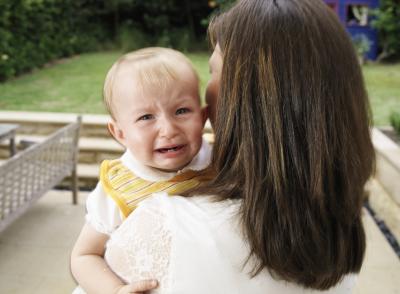The baby is crying incessantly. Nothing you do stops the ongoing noise. The stress, anger and frustration become so great that you pick up the baby and shake him. You didn’t mean to harm him, but you just made a terrible mistake and committed child abuse. No one should ever shake a baby; this act has grave consequences, including irreversible brain damage and even death.
Causes
Playing with your baby in a normal bouncing-on-the-knee sort of way does not cause shaken baby syndrome, also called abusive head trauma, shaken impact syndrome, infant whiplash syndrome or inflicted head injury. What does cause shaken baby syndrome is a deliberate and violent act in which the parent or caregiver shakes the baby back and forth, causing damage.
Victims and Abusers
Most victims of shaken baby syndrome are between 3 and 8 months old, and 60 percent of victims are male. Between 65 and 95 percent of the time, the abuser is a male in his early twenties, according to the KidsHealth website. He is usually the baby’s father or the mother’s boyfriend. Other risk factors are caregivers who have unrealistic expectations for a baby, a household where there is domestic violence, alcohol or substance abuse, depression or a history of the caregiver being mistreated as a child.
What Happens
When you shake a baby, the baby’s head rotates uncontrollably. A baby’s neck muscles are not yet developed all the way. The baby’s head flies back and forth, causing the brain to hit the skull. This causes bleeding and bruising. If the abuser throws that baby down after the shaking incident, more damage, such as swelling in the brain, can happen. Shaking a baby can result in blindness, hearing loss, seizures, developmental delays, learning difficulties, memory problems, mental retardation and cerebral palsy.
Delayed Damage
If the baby doesn’t display any obvious signs of damage, that doesn’t mean there aren’t any. Sometimes, no one notices the damage until the child enters school. Behavioral problems or learning difficulties can be because of a shaking incident, but because of the time span, it is difficult to link the two. Symptoms to look for to determine whether someone may have shaken your infant are lethargy, vomiting, irritability, poor sucking, a decreased appetite, rigidity, seizures, unequal pupil size, inability to lift the head and an inability to track movement.
Prevention
Shaken baby syndrome is totally preventable. Caregivers must learn other ways to cope with a crying baby. Nationally renowned pediatrician Dr. Harvey Karp offers the “five S’s” solution to calm a crying baby. Shushing is using white noise that mimics womb sounds. Side positioning helps the baby digest and calms the stomach. Sucking by breastfeeding or by using a pacifier often helps. Swaddling, by wrapping the baby tightly in a blanket, helps the baby feel secure. Swinging in a chair or infant swing helps simulate the motion the baby felt in the womb. If nothing you do stops the crying, call your doctor; there may be a medical reason. Never shake your baby.





